Configuration Guide - NSA, Carrier Aggregation
This tutorial is not about how to use or how to test anything. If is more for information purpose. It is about how to figure out proper frequency, bandwidth and band combination for various NSA or Carrier Aggregation test that you want to perform. In theory, this configuration should not be so complicated. Just setting ARFCN and bandwidth allowed by some of 3GPP tables (e.g, 38.104 - Table 5.4.3.1-1, Table 5.4.2.3-2), however when you are trying to configure some NSA, Carrier Aggregation on your own you would notice that it is much trickier than you thought. There are many more additional restrictions explicitely specified various other tables and implicitely imposed somewhere else. Going through all those tables and implicit restrictions scatterred in multiple 3GPP document is tedious job.
What I am going to do in this tutorial is to provide some guide lines and tips to find proper conditions(e.g, frequency, bandwidth, band combination etc) from the site sqimway.com which consolidates all the tables and formulas in such a way to help us to figure out various details so easily. Of course, even with this tool you would not be able to get the specific configuration with single button click, but it would be much easier than searching through the 3GPP specification directly or evaluating various formula by youself.
In addition to the guide, I will try to provide specific example configurations for Amarisoft Callbox (eNB, gNB) and Amarisoft UEsim so that you can get tangible understanding and try on your own. Under each section, there is a table that list Amarisoft configuration files that belong to a specific category of NSA and Carrier Aggregation. You may just download the configuration file and use it as it is or use it just a little bit of modification as per your test requirement.
This is going to be long / ongoing document that cannot be done over night. I will start with just a few cases and examples first and will update the document continuously.
- 38.521-3 : UE conformance specification; Radio transmission and reception; Part 3: Range 1 and Range 2 Interworking operation with other radios
- 38.521-2 : UE conformance specification; Radio transmission and reception; Part 2: Range 2 standalone
Table of Contents
- Configuration Guide - NSA, Carrier Aggregation
LTE
These are tips to find a configuration for various scenarios for LTE carrier aggregation.
2 LTE with Intraband and noncontiguous
This is the case of carrier aggregation with two LTE cells in the same band where two LTE channels are non-contiguous
Just check out this table at sqimway.com and make it sure that your band combination belong to one of the category and ensure that your UE capability information properly notify the category.
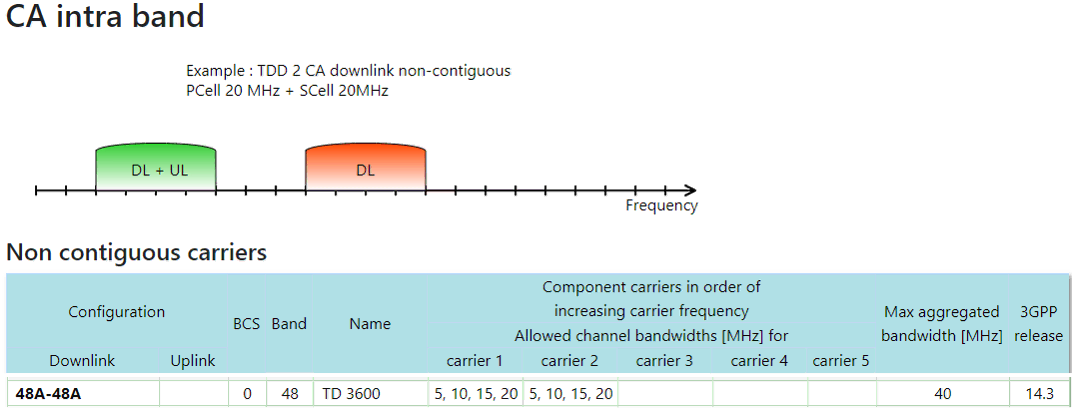
Examples : Download configuration that is closest to your test requirement and modify it as necessary
|
CA Configuration |
# of CC |
{CBW,...} |
eNB Configuration |
UEsim Configuration |
Log |
|
48A-48A |
2 |
{20,20} |
2 LTE with Interband
This is the case of carrier aggregation with two LTE cells in the same band where two LTE channels are non-contiguous
Just check out this table at sqimway.com and make it sure that your band combination belong to one of the category and ensure that your UE capability information properly notify the category.
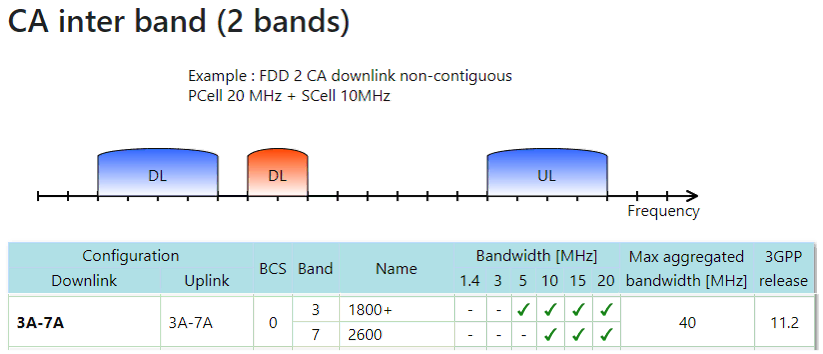
Examples : Download configuration that is closest to your test requirement and modify it as necessary
|
CA Configuration |
# of CC |
{CBW,...} |
eNB Configuration |
UEsim Configuration |
Log |
|
3A-7A |
2 |
{5,5} |
|
||
| 3A-7A |
2 |
{5,5} |
|
||
3A-7A |
2 |
{5,5} |
|
FR1-NSA : Single/Multi LTE and Single NR
These are tips to find a configuration for NSA that uses Single or multiple LTE cells and only one NR cell.
1 LTE and 1 NR
Starting with the simplest case. That is an NSA configuration with only 1 LTE cell and 1 NR cell.
Just check out this table at sqimway.com and make it sure that your band combination belong to one of the category and ensure that your UE capability information properly notify the category.

Examples : Download configuration that is closest to your test requirement and modify it as necessary
|
ENDC Configuration |
# of CC/LTE |
# of CC/NR |
CBW/LTE |
CBW/NR |
eNB/gNB Configuration |
UEsim Configuration |
Log |
| DC_1A_n78A |
1 |
1 |
{20} |
{20} |
|
2 LTE and 1 NR
Starting with the simplest case. That is an NSA configuration with only 2 LTE cells and 1 NR cell.
Just check out this table at sqimway.com and make it sure that your band combination belong to one of the category and ensure that your UE capability information properly notify the category.

Examples : Download configuration that is closest to your test requirement and modify it as necessary
|
ENDC Configuration |
# of CC/LTE |
# of CC/NR |
CBW/LTE |
CBW/NR |
eNB/gNB Configuration |
UEsim Configuration |
Log |
|
DC_1A_7A_n78A |
2 |
1 |
{20,20} |
{100} |
|
|
|
|
DC_1A_3A_n78A |
2 |
1 |
{20,20} |
{20} |
|
|
6 LTE and 1 NR
This is the case where 6 LTE cell in Carrier aggregation and one NR cell added for NSA setup. To create a setup in your mind, check out this table at sqimway.com and make it sure that your band combination belong to one of the category and ensure that your UE capability information properly notify the category.

Examples : Download configuration that is closest to your test requirement and modify it as necessary
|
ENDC Configuration |
# of CC/LTE |
# of CC/NR |
CBW/LTE |
CBW/NR |
eNB/gNB Configuration |
UEsim Configuration |
Log |
|
DC_1A-3C-7C-28A_n78 |
6 |
1 |
{20,20,20,20,20,20} |
{100} |
|
FR1-Carrier Aggregation : Intraband Contiguous
Intraband Contiguous mean that more than 2 carriers (cells) belong to the same band and positioned right next to each other. For the configuration of this case, check out this table at sqimway.com for band combination and this table for band class and make it sure that your band combination belong to one of the category and ensure that your UE capability information properly notify the category.
This is an example from the table. First find out the band and band class that you want to configure from these two tables : band table and class table
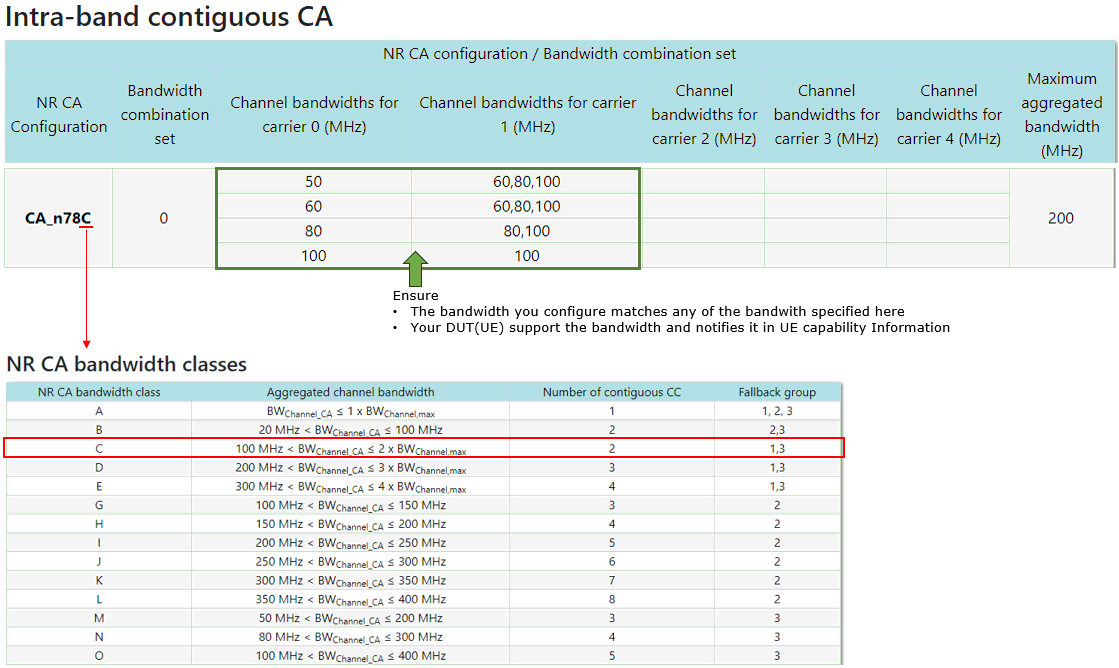
There is another challengy for contiguous carrier settings because you should put the two adjacent carriers in a very specific carrier spacing. For example, let's suppose that you want to put two carriers contiguously as shown in the illustration below (the figure on the left). You may arbitrarily set the carrier frequency of the first band (labeled as (1)), but you cannot put the carrier frequency of the adjacent carrier (labeled as (2)) because it should meet the condition of 'contiguity'. If you have tried to figure it out on your own by hand, you would know how tedius and confusing it is. Luckily this table (the table on the right) on sqimway.com come in to help again. This table does not give you the frequency of the adjacent carrier (i.e (2)) directly. Instead, it gives the carrier spacing between the center frequencies of the two carriers (i.e, (2)-(1) in the unit of Mhz). The way to read this table is like this. Let's assume that the head of each row(A) represents the bandwidth of the first carrier and the head of each column(B) represents the bandwidth of the second(adjacent) carrier. The number (in black) at the cross section of (A) and (B) represents the frequency spacing between the center frequencies of the two carriers (i.e, (2)-(1) in the unit of Mhz) which is labeled as (C)
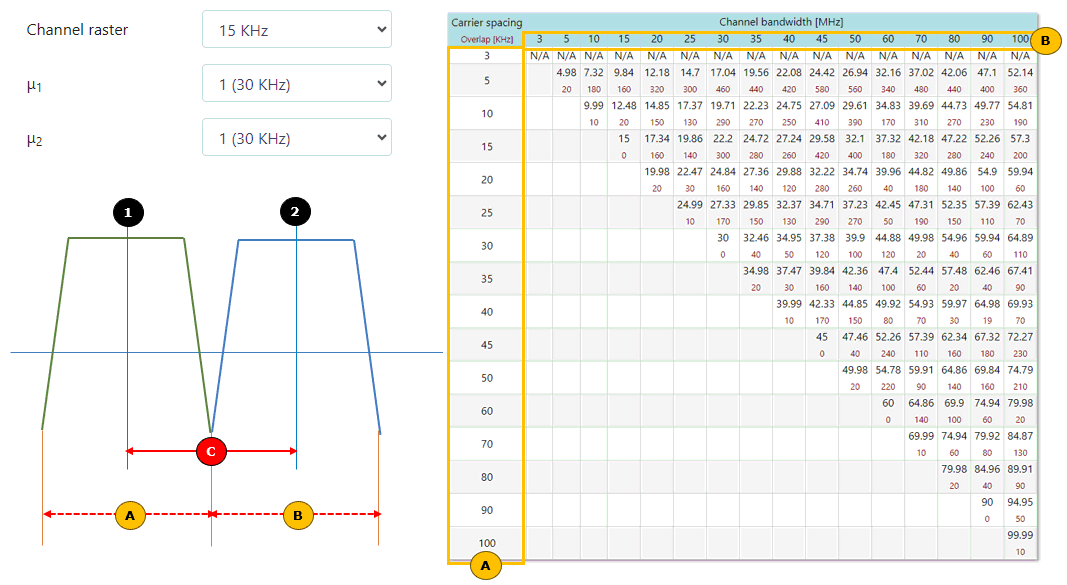
Let's take a specific example as illustrated below. I want to configure a carrier aggregation with two contiguous band and both carriers has 100Mhz bandwidth each. Assume that the center frequency of the first carrier is 3558.99 (EARFCN 637266). How can I figure out the frequency/ARFCN for the second (adjacent) carrier ?
Simple. Take the row labeled as '100'(A) for the bandwidth of the first carrier and take the column labeled as '100'(B) for the bandwidth of the second carrier. The number at the cross point of the indicated row and column indicates the frequency spacing between the two adjacent carriers which is 99.99 Mhz in this case. With this information, you can easily calculate the frequency and derive EARFCN for the second carrier (marked as (2)) by simple calculation (NOTE : deriving EARFCN from the physical frequency would not be easily done by hand. Again, it is better to use this calculator at sqimway.com ).
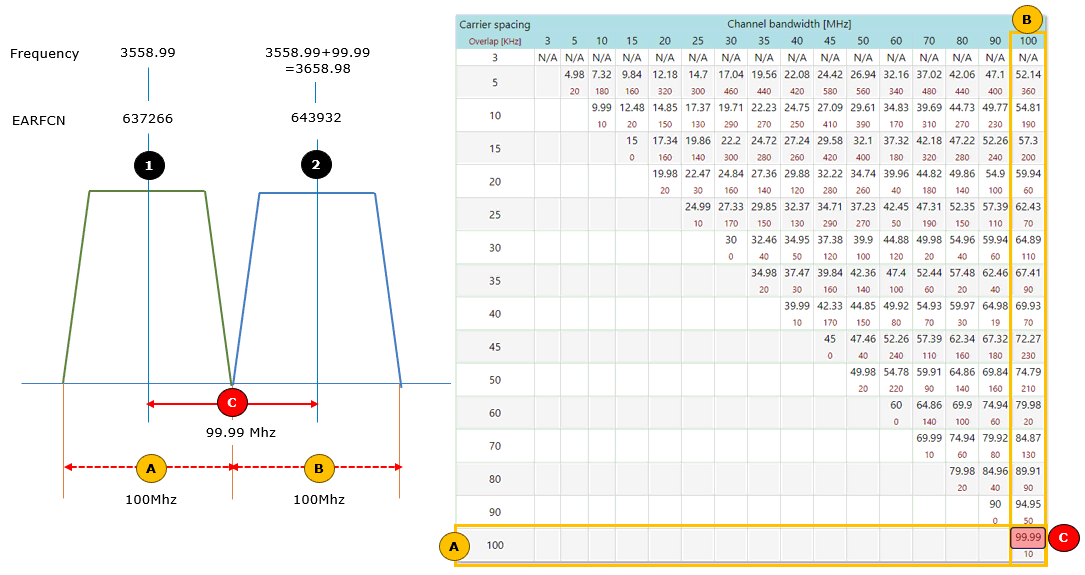
Examples : Download configuration that is closest to your test requirement and modify it as necessary
|
ENDC Configuration |
# of CC |
CBW |
eNB/gNB Configuration |
UEsim Configuration |
Log |
FR1-Carrier Aggregation : Intraband NonContiguous
Intraband Contiguous mean that more than 2 carriers (cells) belong to the same band and positioned right next to each other. For the configuration of this case, check out this table at sqimway.com for band combination and this table for band class and make it sure that your band combination belong to one of the category and ensure that your UE capability information properly notify the category.
This is an example from the table. First find out the band and band class that you want to configure from these two tables : band table and class table

Examples : Download configuration that is closest to your test requirement and modify it as necessary
|
ENDC Configuration |
# of CC |
CBW |
eNB/gNB Configuration |
UEsim Configuration |
Log |
|
CA_n78(2A) |
2 |
{20,20) |
|||
|
CA_n78(2A) |
2 |
{20,20) |
|||
|
CA_n48(3A) |
3 |
{40,40,40} |
FR1-Carrier Aggregation : Interband
Intraband Contiguous mean that more than 2 carriers (cells) belong to the same band and positioned right next to each other. For the configuration of this case, check out this table at sqimway.com for band combination and this table for band class and make it sure that your band combination belong to one of the category and ensure that your UE capability information properly notify the category.
2 bands
This is an example from the table. First find out the band and band class that you want to configure from these two tables : band table and class table

Examples : Download configuration that is closest to your test requirement and modify it as necessary
|
ENDC Configuration |
# of CC |
CBW |
eNB/gNB Configuration |
UEsim Configuration |
Log |
| CA_n5A_n78A |
2 |
{20,20) |
|
||
| CA_n5A_n78A |
2 |
{20,20) |